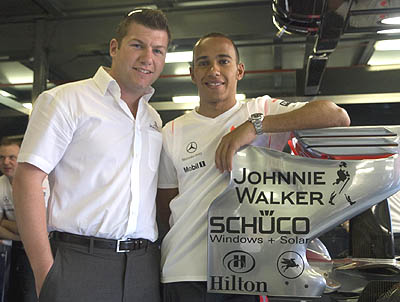


23/03/2009
NEWS STORY
 |
It's hard to tell which of the above gents has the bigger grin. The photo was taken last year as Hamilton was storming his way to his first World Championship so his beaming smile is understandable. Joining him is Robin Fenwick, Hilton's director of sport sponsorship and an article in the Sunday Express by Pitpass' business editor Chris Sylt explains why there is good reason for his grin.
Scarcely a week goes by without an article appearing in the press berating banks for their sports sponsorships. The amount spent by RBS on its sponsorship of Williams made the front pages of the papers and Honda's exit from F1 was on most TV stations around the globe. Being an F1 sponsor during an economic downturn is not usually something to be proud of due to the huge cost involved. Hilton is the exception.
F1 sponsors are some of the most secretive in the world of sport when it comes to releasing any details of the amount they spend and the return on their investment. Quite understandable. But with sources at the top at Hilton, Sylt has managed to lift the lid and his report shows how to turn the wheels of an F1 sponsorship without fuelling it with tens of millions of dollars.
Sylt has discovered that last year Hilton made $15.9m from its F1 sponsorship which gives it a logo on the side of the McLaren's rear wing. The deal costs the hotel company an estimated $3m annually giving it a return of over five times.
Fenwick is the man responsible for turning the wheels of Hilton's deal and he says "since joining F1 in 2005, Hilton has doubled the revenue generated each year and just last year trebled the revenue from 2007."
Whilst many companies have hit a roadblock when it comes to justifying F1 sponsorship, Hilton has accelerated its returns by focussing on the business-to-business aspect of its involvement. Most F1 sponsors use the sport to reach the millions of consumers who watch it but this requires spending more money in addition to the amount spent on the sponsorship itself. This is because the sponsors need to spend additional sums, known as leverage, on advertising the fact that they are involved with F1 in order to make the most of it. In contrast, by aiming the sponsorship at a business audience, Hilton can get returns without much additional outlay.
Over 260 brands partner F1 and Hilton has signed supplier deals with sponsors such as Philips and Diageo, owner of fellow McLaren partner Johnnie Walker, through relationships forged in the paddock. Hilton also invites hotel owners into F1's corporate hospitality area in order to build relationships with them. This drove Hilton's business-to-business revenue from F1 to $9.2m in 2008. Yet it doesn't spend vast sums on F1 and last year only entertained 220 F1 corporate hospitality guests. In contrast, RBS took double this number to the Singapore Grand Prix alone.
In addition to its business-to-business success, Hilton uses its F1 sponsorship to drive its core business of filling rooms. F1 generated $5.5m in bookings for Hilton last year from the 20,000 members of its loyalty scheme. As the only hotel company to sponsor F1 Hilton also gets bulk bookings from within the sport with some of its biggest clients spending $2m alone. Fenwick has developed savvy incentives to boost this further such as offering a 50% discount on leisure stays to partners which provide significant business to Hilton's sponsorship team.
Although the F1 logos give $1.2m in media value for Hilton, the sponsorship gets wide exposure by being mentioned frequently in travel articles and competitions. Fenwick has also spearheaded smart strategies such as offering F1 corporate hospitality passes to tempt newspaper travel editors to cover the Hilton in the area where the race is taking place. The proof of the pudding is that last year Hilton was ranked as the 7th most-exposed F1 sponsor in print media and the sponsor offering the third-best value for money invested.
"One of the aims at the start of the partnership three years ago was to try and reach the new generation of young and affluent international travellers, and this is being achieved," adds Fenwick. Some would say that this is something Hilton badly needed after its reputation had begun to fade in recent years. F1 (and a multi-million dollar makeover of its hotels) has turned this around and Hilton even makes the most of its relationship with McLaren in the hotels themselves.
At race-time, the staff in the Hiltons near to the F1 circuits are dressed in McLaren team colours, show cars adorn the lobbies and images of the McLaren are projected onto the outside of the hotels. It is invaluable publicity not just for Hilton, but for McLaren and F1 itself too given the sport's lack of marketing.
Hilton has set the standard for driving a sponsorship deal from a low cost base and given the economic downturn, F1's big spenders should take note.